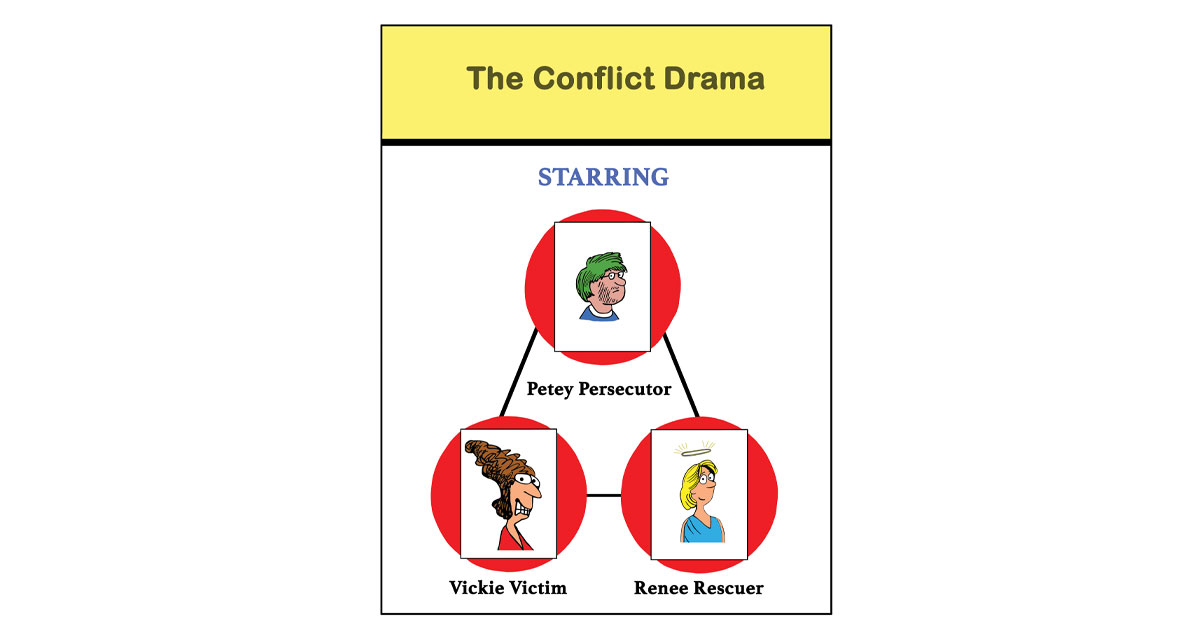Do you have drama in your workplace? Apparently, most of us do. Research shows that the average employee spends two hours and 26 minutes per day on drama and emotional waste (Cy Wakeman).
Unfortunately, increased drama in your business is more than just a leadership headache – it directly impacts your bottom line. The more your team engages in drama, the less they are focused on your customers and their performance.
As much as we don’t want to admit it, we may often play a part in escalating drama based on the role(s) that we slip into. Have you ever heard of the Drama Triangle? It was developed by Psychiatrist Steven Karpman in the early 1970s. It is a social model of human interaction that maps a type of destructive interaction that can occur among people when things get stressful or dysfunctional – which, let’s face it, happens a lot! There are three roles that we often play in drama – the Persecutor, the Victim and the Rescuer.
The Persecutor – “It’s all your fault”
The Persecutor (aka the Villain) is the trouble causer. He or she is often dominating, blaming others or tearing them down. Persecutors feel superior and desire to have a sense of power and control. They seek rescue by pinpointing problems and directing others as the primary cause of those problems. The validation of their beliefs comes from seeking a victim to hold accountable for their problems and manipulating them into working their way.
The Victim – “This is happening to me”
The Victim has kind of a “poor me” attitude, and they feel picked on by the Persecutor. He/she feels helpless and powerless and has trouble solving problems or making decisions – and looks to the Rescuer to save them.
The Rescuer – “I need to save others”
The Rescuer (aka the Hero) intervenes for the victim. Rescuers may even see themselves as a hero, solving everyones’ problems. The Rescuer is the go-to person, the sponge for all things needing to be done. If they become aware of a Victim, they may respond with something like, “Poor thing, don’t worry. I will help to fix this situation for you.” Their motivation is to feel wanted and valued. It may even be to really help, but in doing so, they derail the Victim by constantly jumping in to solve their problems.
Most of us slip into all of these roles from time to time but tend to favor one over the others. It’s a vicious cycle, and it goes round and round, creating massive problems and dysfunctional behaviors.
8Transforming the Drama Triangle
The first step is to begin to recognize when the Drama Triangle is coming into play and adjust your behavior to break the pattern. Here is how you can transition to be more effective and end the drama cycle.
Persecutor to Challenger. If you find yourself moving toward the Persecutor role, try to shift into the Challenger role. This involves initiating change and healthy conflict in a more positive, less intimidating way.
Victim to Creator. If you start to shift into the Victim role, move yourself into the Creator role. Creators initiate positive change in the organization. To be effective in this role, you must learn how to communicate what you need and take healthy action yourself. It may take a little coaching to get there, but you can do it!
Rescuer to Coach. If you tend to be a Rescuer like me, coach the Victim to solve their own problems. As the Coach, you will provide support, without fixing the problem yourself. You will need to encourage Creators as they often lack confidence and aren’t used to doing things on their own. And, you will have to resist the urge to fix everything.
Drama takes time and energy away from your organization and the bottom line. Now that you understand it, you can derail the Drama Triangle to stop the cycle!



















